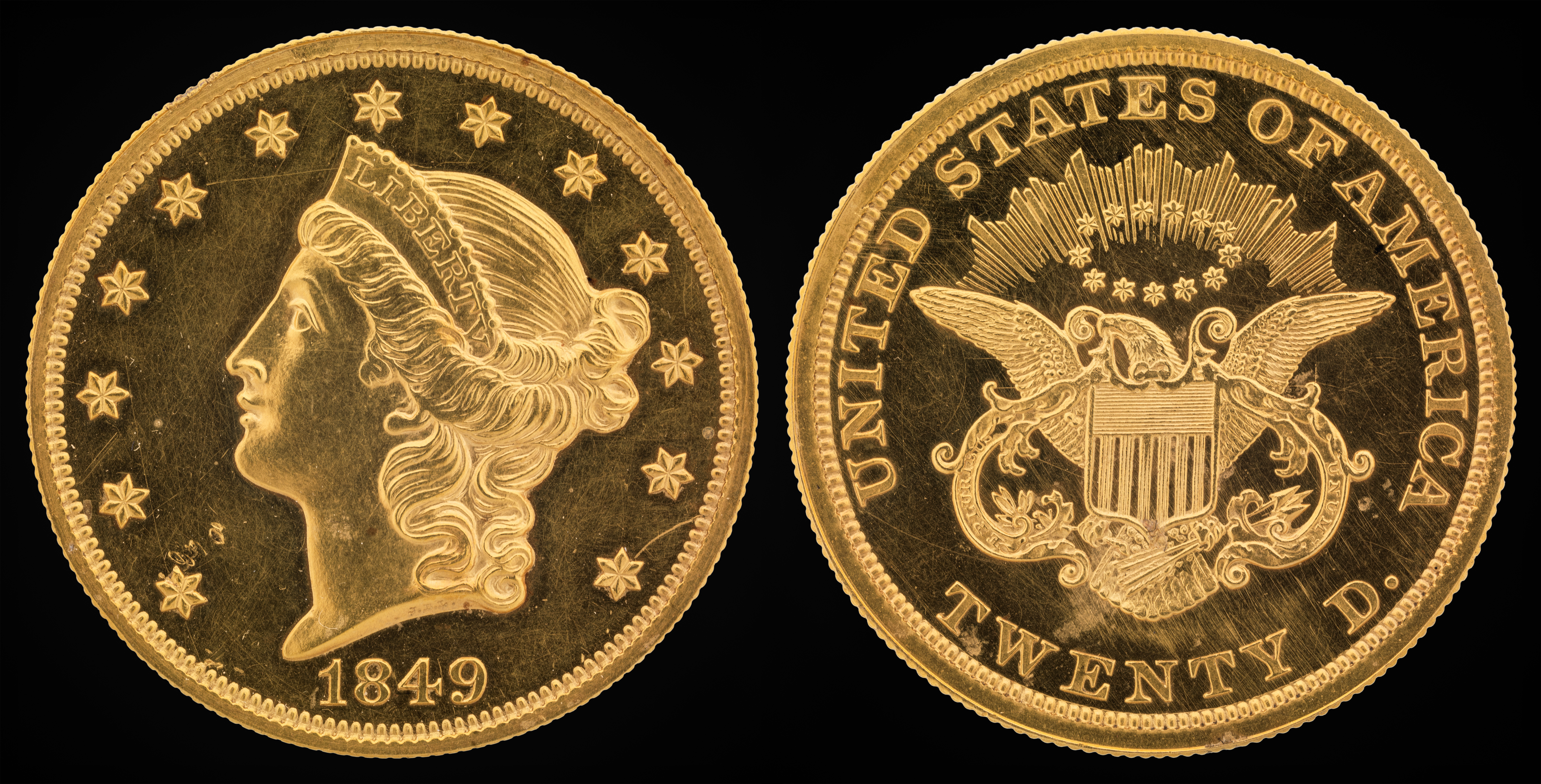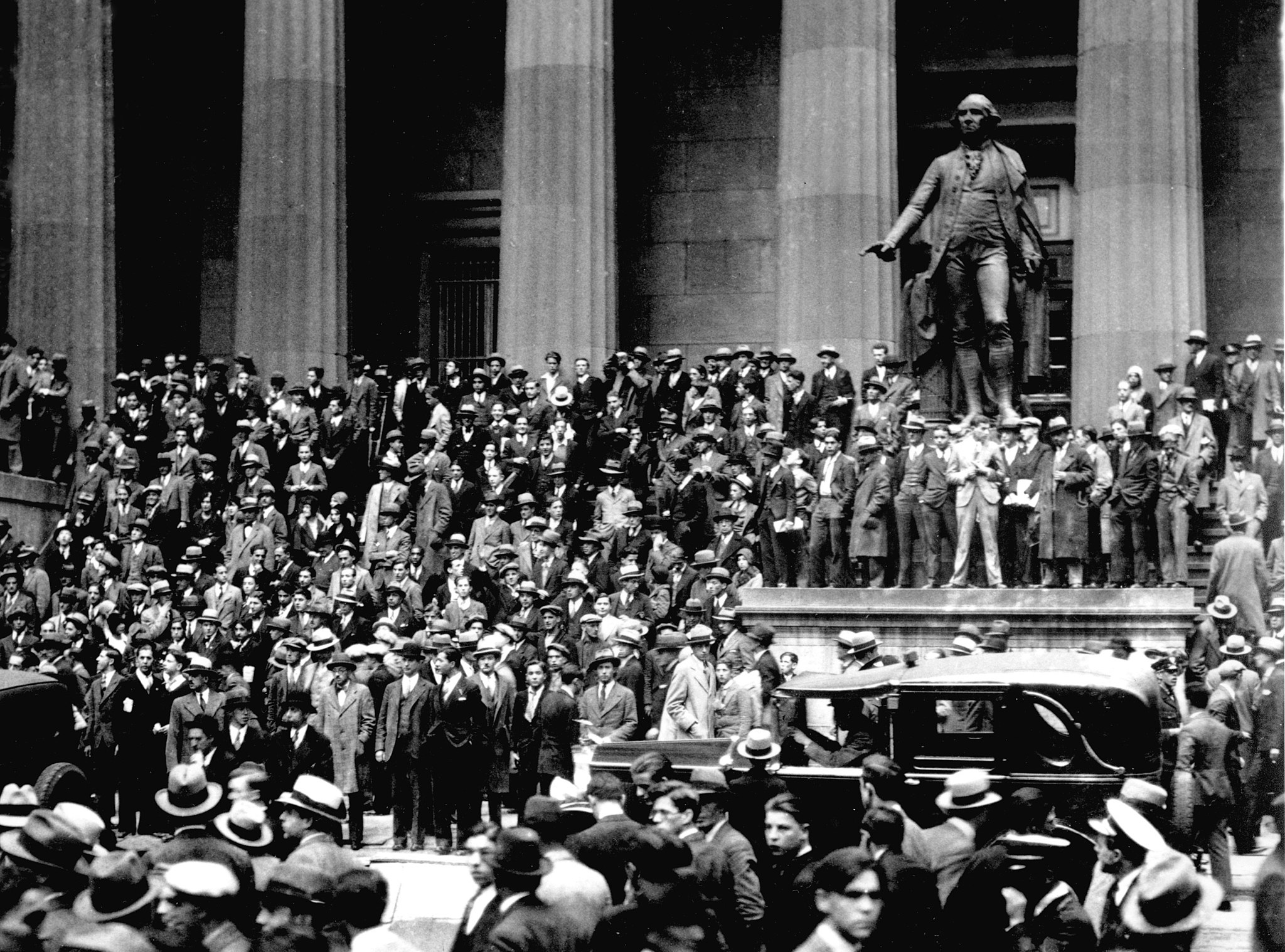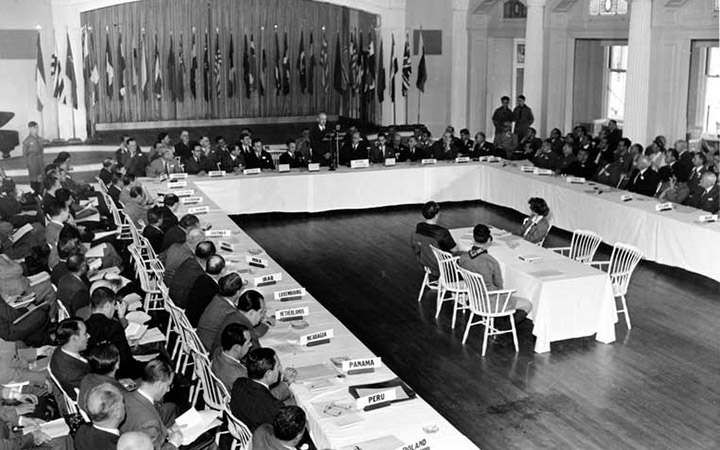Explainer: How the Bretton Woods Agreement Gave A New Lease on Life to the Gold Standard Before Collapsing Entirely

An 1849 American Gold Eagle, with a face value of $20, it had a content of 0.9675 Fine Ounces
Image:US Mint (coin), National Numismatic Collection (photograph by Jaclyn Nash)CC0 1.0,Public domain, via Wikimedia Commons
Explainer Article – Not opinion, written to improve my own understanding.
In June 1944, Allies forces had landed in Normandy, taken Rome and the Soviet Union’s counter offensive into eastern Europe was in full swing. The writing was on the wall for the German Reich, even though it wouldn’t capitulate until almost a year later in May 1945.
Such was the western powers’ confidence that in July 1944 delegates met in the small resort town of Carroll, New Hampshire. More specifically at the Mount Washington Hotel Spa and Golf Course in the eponymous Bretton Woods. To discuss the post-war international monetary order.
Why did this need to be so urgently addressed?
The gold standard had caused instability in the 30s because it put countries that adopted it in a monetary ‘straight jacket’ that we will explore further, and equally, the free-floating exchange rate system that followed was wracked with chaos as currency values were manipulated for short-term gain.
The goal of the Bretton-Woods agreement was to design a workable third way to bring a monetary order to the post-war world.
How did the gold standard work?
Before 1914, currencies such as the British Pound were convertible into gold at a fixed price. This meant that you could turn to the central bank to exchange your paper money for a given weight of gold. As other central banks did the same, it effectively determined a fixed exchange rate between currencies based on their relative value in gold.
In 1900, the price of a fine ounce in Britain was £4.25 and $20.67 in America. Therefore, based on this system you could calculate the relative exchange rate.
1 fine ounce = £4.25= $20.67
And so the exchange rate for pounds to dollars ($/£) = (20.67/4.25) = 4.864
What did this mean for trade?
The fixed quantity of gold meant that the money supply was also fixed, in theory this ensured that trade imbalances would be rectified automatically.
If, for example, the UK ran a current account deficit (Importing more than it exported), the central bank’s gold reserves would be depleted as Brits would convert their pounds into gold to settle their international debts. As this happened, the total supply of pounds held in the UK, outside the central bank would decrease. This reduction in the money supply would cause the cost of borrowing to rise, as a result, consumers and businesses would have less money to spend and invest. The resulting fall in demand would decrease the quantity of imports and, as deflation set in, reduce the price of British goods, boosting exports. As a result, this effect would in theory reverse the trade imbalance.
This process would often be slow and painful and so the central bank would intervene. it would raise interest rates if there was a trade deficit, attracting savers to put their money into pounds and depositing gold into the Bank of England’s vault, and lower interest rates in the event of a trade surplus.
What were the drawbacks?
Having a gold standard was useful for trade and controlling inflation but it also meant that the countries that used it were constrained in the following ways.
- The money supply was limited by the quantity of gold.
- The Central Bank had to use interest rates to impact the flow of gold, there was no room to use monetary policy for domestic reasons.
- Economy was tied to the supply of gold – New findings of gold could cause unwanted monetary expansion.
Problem 1:
In the event of a crisis such as a recession or a war, the government has no ability to fund itself through inflationary finance (printing money). As a result, great powers found themselves abandoning the gold standard in times of war and re-pegging the currency to gold afterwards.
Problem 2:
Countries on the gold standard had to work a fine balance with interest rates to ensure that gold was not entering or leaving the economy too quickly.
If gold left too quickly, then the banks on a fractional reserve system would have a reduction in their reserves and be forced to rapidly decrease the amount of loans they gave out causing a credit crunch.
If gold entered too quickly, there would be inflation as more money would be chasing the same number of goods in the domestic economy.
Threatened by these two extremes, central banks could not adjust interest rates in reaction to any other unrelated domestic issues such as a recession or an overheating economy.
How Did a Decrease in Gold reserves affect Credit?
New money is created by commercial banks handing out loans. Their only constraint is the fractional reserve system which dictates that they must not exceed a certain multiple of the value they hold in reserves at the central bank.
Today these reserves are known as M0– Under the gold standard they were held in gold at the central bank.
Let’s say that the law states the bank must hold 10% of the value of its deposits in reserves.
If customers lost confidence in the banking system and wanted to redeem their cash for gold to hold it privately, the banks would first use any physical gold they had, if these supplies dwindled, they would have to turn to the central bank to redeem the bank’s reserves for additional gold. When this happened, the bank would have to reduce the value of its deposits by 10x the value of the gold redeemed. Giving this gold redemption a magnified effect. To do this, they would stop giving out loans, refuse to roll over existing loans or call loans in.
As money gets harder to borrow, interest rates rise – what’s known as a credit crunch.
Problem 3:
As the monetary system at this point was artificially tied to the supply of a metal, new findings of it would affect inflation and competitiveness. The most prominent example is the Spanish Price Revolution in the 16th and 17th centuries.
Spanish Price Revolution
The Spanish empire consisted of major holdings in America. In countries such as Mexico Peru and Bolivia, the Spanish colonists could mine huge quantities if gold and silver cheaply. The precious metals were largely transported back to Europe on treasure fleets. The surplus in gold and silver held in Spain by the crown and in private hands caused inflation. As the price of goods increased in gold terms, Spain lost export competitiveness, this effect is known as “Dutch Disease”– as a result it became an importer of goods it had previously exported, and Spanish industry began a period of stagnation.

Potosi, A regional capital in Bolivia and home to the Spanish Colonial Silver Mint from 1773 to 1951
Image:Roman Korzh, CC BY-NC-ND 2.0, via Flickr
How did the gold standard come to an end in Europe?
The gold standard collapsed in Europe two main stages,
The first world war forced the European powers to suspend gold convertibility to engage in inflationary finance. The central banks were given free rein to create new money that wasn’t backed by gold to purchase government debt and pay for the war effort.
At the conclusion of the war, after the aggressive spending, the victorious powers imposed heavy reparations onto the defeated ones, to indemnify them for the costs of the war and to bolster their own gold reserves so that they could reintroduce the gold standard in the 1920s.
However, the interwar gold standard did not last long in France and Britain, by the 1930s, the backdrop of the great depression brought the viability of the gold standard into question again and both countries abandoned the gold standard for a final time.
The US, less affected by the war, maintained the gold standard until the 1930s, when it was briefly suspended and then reintroduced.
Britain
When the gold standard was reintroduced under Churchill in 1925, it was decided to peg value of a fine ounce of gold at its pre-war price of £4.25. This was an overvaluation, as the inflationary spending during the war had massively increased the quantity of money in circulation and Britain’s gold reserves, even with German war reparations could not cover it all.
The overvaluation caused Britain to become uncompetitive as its goods cost far more in gold terms than other countries. Foreign holders of pounds exploited this overvaluation and converted their holdings into gold. Usually, the central bank would respond by increasing interest rates to attract investors and prevent capital flight, however, the ailing British manufacturing sector affected by the overvaluation and the great depression would not be able to survive a hike in interest rates. So in 1931, gold convertibility was suspended and the pound devalued by around 30%.
USA
The 1929 New York Stock Market crashed, and billions were wiped out. One of the most important effect of this crash was that is eroded confidence in the American banking system. But why would customers want to withdraw all their deposits in the event of a stock market crash? Because, before the Glass-Steagall act in 1933, created in reaction to the crisis, banks did not separate their commercial and investment banking divisions. As a result, banks were using depositor’s money to speculate on the stock market. When the market crashed, customers were correct to assume that the bank would not have enough assets to cover their deposits.

People gather on the sub-treasury building steps across from the New York Stock Exchange in New York on "Black Thursday," Oct. 24, 1929.
Image: Associated Press, CC0 1.0 Public Domain, via Wikimedia Commons
So as American and foreign depositors withdrew their cash, they converted it into gold as a hedge against devaluation of the dollar. Due to the fractional reserve system, this redemption of gold, meant a reduction in the quantity of loans that banks could give. As a result,there was a credit crunch, deflation and interest rates shot up.
The federal reserve quickly found itself running out of gold to honour the redemption requests. In 1933 when the New York Fed announced that it could no longer honour its commitment to convert currency into gold, Roosevelt declared a national banking holiday.
France
In France, they had accepted that their currency had devalued hugely over the course of the second world war and re-established the gold standard with the franc at a fifth of its pre-war value. This actually meant that unlike in Britain, the Franc was undervalued. The initially sober decision was undermined by bad policy over the next few years.
Initially, this undervaluation made France very competitive and drew savers money into investments in France, building up massive gold reserves. An influx of buyers of Francs put a stop to the hyperinflation that had plagued France previously. However, policymakers in France were obsessed with two counterproductive policy objectives – gold hoarding and deflation.
France’s increase in gold reserves would have normally meant an increase in the money supply. However, the Bank of France ‘sterilised’ some of its new gold reserves and did not allow any new money to be created. This meant that even if all deposits at the central bank were redeemed for gold, there would be a large amount left.
Due to sterilisation, as more and more money was invested into France, the value of the Franc increased dramatically in gold terms because the money supply didn’t grow. Deflation ensued, the price of goods in Francs fell and so did wages due to a wage-price spiral. Policymakers were happy with deflation because they wanted the price levels to return to their prewar state, in a ‘correction.’
As a result of deflation, consumers and businesses delayed spending because costs were constantly falling. Businesses, with revenues dropping and the value of debt increasing, cut wages.
When both Britain and the USA left the gold standard, their currency values dropped. Now it was the Franc that was overvalued. Gold reserves plummeted until the central bank was drained. In 1936 a socialist party came into power, riding a tide of unrest from high unemployment and suspended the gold standard indefinitely.
The Second World War and Bretton Woods.
The second world war left Europe decimated and fuelled an American boom. America emerged in the 40s as the only great power with a gold-based monetary system.
The alternative monetary system without gold had little credibility. Countries had engaged in strategic currency devaluation to increase their trade competitiveness in a manner that was perceived as unfair. And rampant speculation on the future value of currencies created capital flows that generated large fluctuations in exchange rates.
The Bretton-Woods System tried to find a third way based on the key monetary lessons of the past 40 years:
- The gold standard was unworkable in times of crisis as it meant that governments had limited control over monetary policy to pursue other objectives such as full employment or inflation targets. As a result, it was conceded that European powers, ravaged by war would have to abandon it.
- During the first world war and the interwar years, the collapse of the gold standard and subsequent exchange rate turmoil caused chaos in international trade.
- Capital flows had a large speculative component that hampered exchange rate stability.
The Bretton-Woods System therefore agreed to replace gold with US Dollars as the global reserve currency – to be used to settle international transactions. At this point, the US was the only economy that maintained the convertibility of gold and so to provide a degree of stability to the system this was maintained. It also helped that by 1944, due to capital flight from Europe and Asia, the US held 2/3rds of total world gold reserves.
To address the chaos of free-floating exchange rates it was agreed that countries would maintain fixed exchange rates with each other, but they could be adjusted in the future to reflect a ‘fundamental disequilibrium.’ Signatories of Bretton-Woods agreed to peg the value of their currencies within a 1% band of an agreed value of USD by intervening in their foreign exchange markets.

UN Monetary Conference, Bretton Woods, 1944.
Image: Associated Press/Abe Fox
So, in effect, the gold standard had a partial revival, as European currencies were pegged to USD which was convertible to gold.
The initial issue with this system was that it was not fit for the global economic situation, the US’ economy was booming whilst war-torn Europe was struggling to produce enough food to sustain itself. Europeans needed American goods but could not earn enough dollars to pay for them. The US addressed this by issuing grants to European countries and encouraging them to devalue their currencies to gain trade competitiveness with the US. A dramatic example of this is the pound, which was pegged at £1=$4.03 in 1948, by 1950 it was set to $2.80.
Although the short-term issue with the Bretton-Woods System was now addressed, the structural issue remained, identified by Robert Triffin in the 1960s. As a global reserve currency, the US dollar had to be sufficiently abundant to provide liquidity for global trade but not so abundant as to undermine the trust in its gold convertibility.
The US dollar could only be abundant internationally if the US ran persistent trade deficits, but these deficits weakened the dollar’s value as gold could be redeemed from the Fed to foreign holders of dollars.
The Marshall plan and devaluation of European currencies resolved the issue of dollar scarcity but due political pressures, leaders were unable to unwind this policy as dollars became more and more abundant. The story of the Bretton Woods system from 1958 onwards is largely one of the US making significant sacrifices in domestic economic policy to maintain the global reserve status of the Dollar and its Gold convertibility at $35 Dollars per troy ounce, but ultimately the political consensus was reached that the short-term costs were just too high.
As dollars became abundant internationally, the credibility of gold convertibility was threatened. If foreign holders of dollars felt that they could purchase gold at the rate offered by the Federal Reserve and sell it for more on the secondary market the temptation to take advantage of the arbitrage opportunity would be enormous. Therefore, the US government decided to accept some economic pain to maintain the system. The federal funds rate was raised in 1958 coinciding with a doubling of the unemployment rate. This encouraged currency speculators to convert to USD to chase the higher yield, bringing dollars back into the US and propping up its value. It also showed that the Federal reserve was committed to maintaining the $35 per troy ounce gold price and so stopped speculators from buying gold.
However, ultimately a recession in 1961 caused the Fed to drop interest rates again, and as a result, the balance of payments issue was re-emerged. In 1964, Johnson’s expansionary budget meant that the US government pumped demand into the economy and spurred inflation.
This, alongside the background of the Vietnam war, which required massive imports of raw materials and oil, deepening the trade deficit, meant that the balance of payments crisis had hit a boiling point, international speculators again started to doubt the ability of the US to maintain the $35 peg to gold and bought as much as they could.
In response, the US turned to a last resort, a ‘Gentleman’s agreement’ with foreign central banks known as the 'Gold Pool.'' They agreed to collaborate with the Fed and intervene in gold markets, by buying or selling gold to keep the price at $35. However, in 1965, France started a unilateral policy of redeeming its dollar reserves for gold and in 1967, withdrew from the Gold Pool, with de Gaulle citing the unfairness of the preferential treatment the US had under the Bretton Woods system. Describing the American position as 'Monumentally overprivileged.'
By 1968 speculation that the US would be forced to devalue the dollar lead to spikes in gold demand as high as $400 Million in a single day. This overwhelmed the resources of the Gold Pool which failed to control the market price. The Gold Pool collapsed and stopped intervening in private markets, instead central banks continued to transact at the $35/Fine Ounce price between each other, yet on private markets, the price jumped to $40. The next year, the gold pool central banks stopped allowing the redemption of gold by private individuals entirely.
In 1971, the US President Nixon, after an announcement full of domestic policy aimed at securing re-election the following year, announced that the Fed would no longer exchange Dollars for Gold at any price.
After a series of meetings, several attempts were made to devalue the dollar with regards to gold, the French were the most strong proponenets of maintaining a gold link. However, this quickly petered out as the American's had no appetite to intervene in private markets again and since 1971, many currencies had already been on a free float. In 1975 an agreement was finally met between the US and France to reflect the new reality.